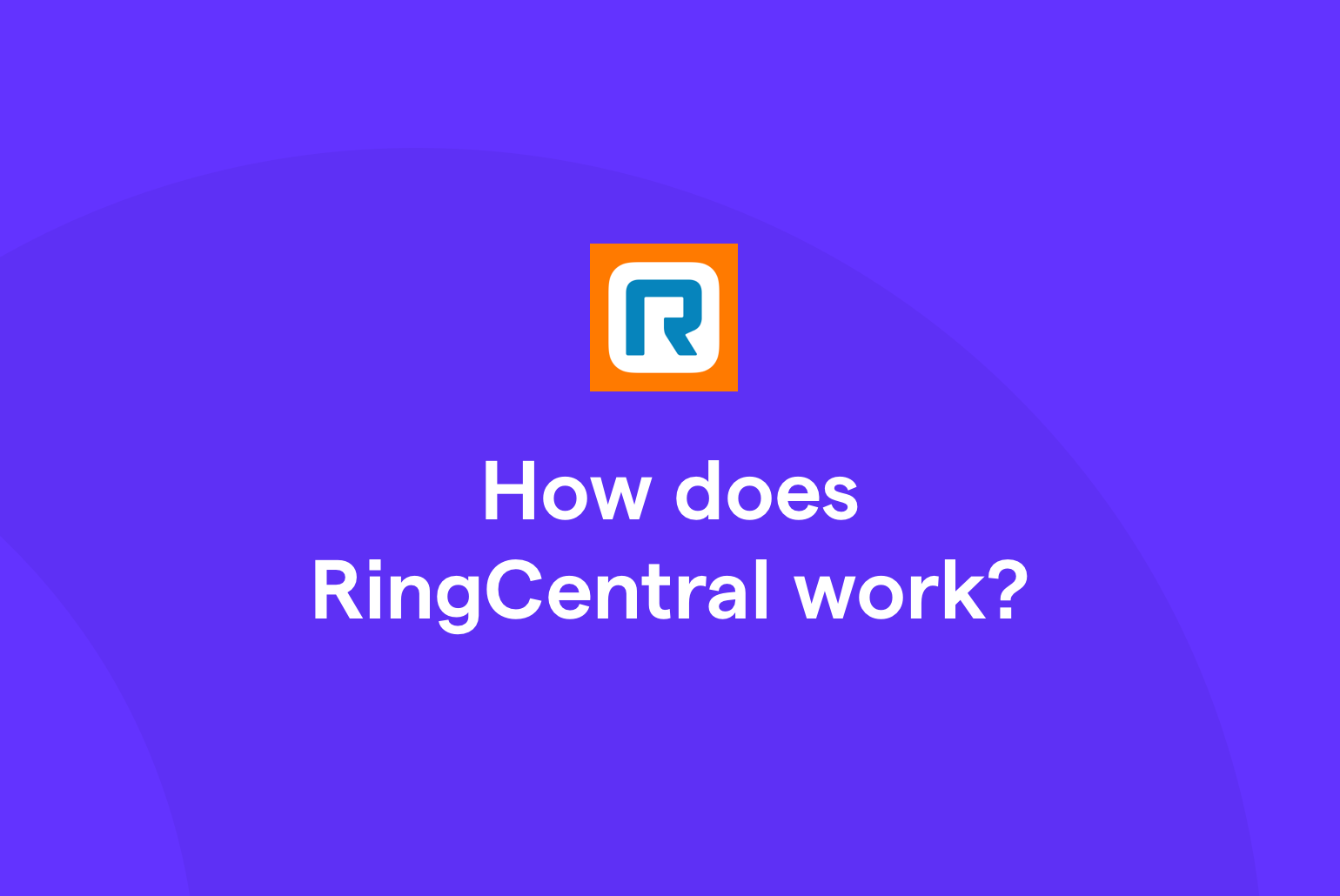If you search online for a business phone system, you might notice RingCentral near the top of your results. So, how does RingCentral work, and will it work for you?
Although RingCentral is heavily advertised, it may not be a good fit for your business. There are many limitations built into RingCentral that bottleneck your ability to develop better relationships with your customers.
We’re going to answer all this and more, explaining:
- How RingCentral works
- How much RingCentral costs
- How to get started with RingCentral
We’re also going to explore nine major RingCentral limitations — and introduce another VoIP phone alternative that can overcome them for your brand.
How does RingCentral work exactly?
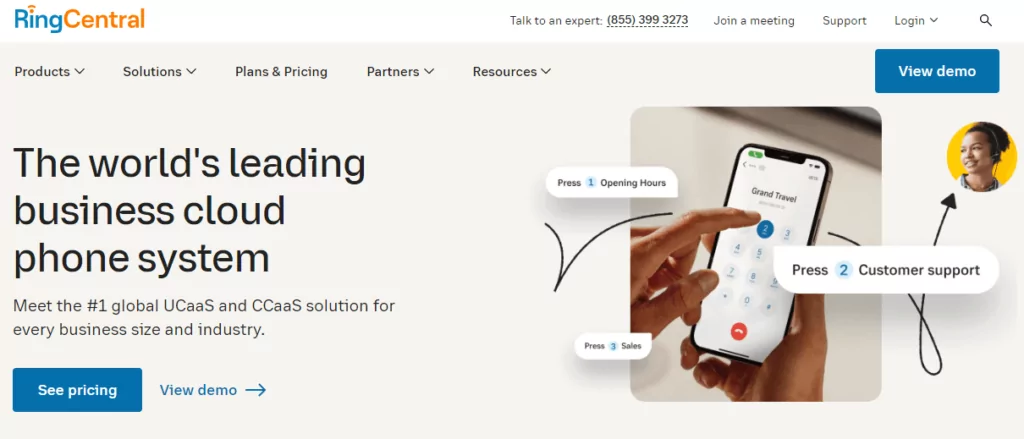
RingCentral uses VoIP technology to create unified communications for customers. This means it combines calls, texts, and video calling tools all on the same plan. As long as you’re connected to the internet, you can use your mobile device, laptop, or desktop computer to make voice calls, send texts, or message team members.
The main features of RingCentral include:
- IVR
- Voicemail transcriptions
- Call recordings
- Local or toll-free phone numbers
- Android and iOS Mobile app
- Business texting
- Team messaging
- Document file sharing
But some of these features you’d expect to be available out of the gate are only available on their higher-tier plans. Next, let’s look at how much you’d actually pay with RingCentral.
How much does RingCentral cost?

Looking to find out how pricing with RingCentral works? RingCentral’s prices are built on economies of scale. Smaller teams pay more per user per month, which might weigh down your budget as a growing business.
There are four pricing plans:
Core
- $20 per user per month
- Get unlimited calls in the US and Canada with business SMS
Advanced
- $25 per user per month
- Access video meetings with voicemail transcriptions, automatic call recording, and CRM integrations
Ultra
- $35 per user per month
- Get additional storage and device analytics
Plus, all the above prices require an annual contract. Some customers even sign up for two-year contracts to reduce their monthly margins. However, if RingCentral doesn’t offer what you want or doesn’t provide enough functionality, you won’t be able to cancel your plan — leaving you stuck for 24 months.
Just check out these RingCentral reviews:
“RingCentral is not willing to reduce the number of lines we originally signed up with, and if we cancel and shut down our business, they will still go after us with a cancellation charge. They have no problem charging us for phone lines we don’t use, but if we increase phone lines, they would charge us for additional lines. They locked me in a two-year contract that I have to pay for lines I will not use.” – G2
“I was forced to sign a two-year contract when I signed on. I made a decision within the first year that I would leave Ring Central once my contract lapsed. There was no consideration that I was a dissatisfied customer. All they could do was repeat that I had a contract and had to pay the three months remaining if I wanted to terminate the service.” – G2
How does RingCentral MVP differ from their contact center plans?
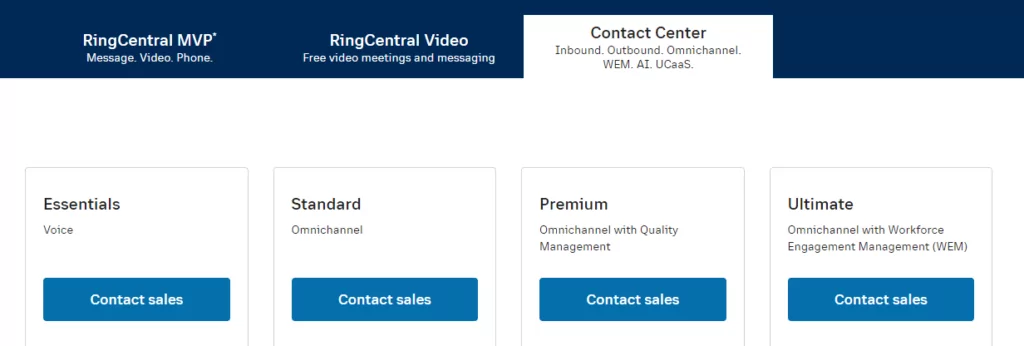
RingCentral MVP and RingCentral Contact Center were built for different purposes. MVP lets you connect with customers through phone calls, videos, and text messages. In contrast, the Contact Center focuses on omnichannel communications, including channels that are unavailable through MVP (like social media, live chat, and email).
RingCentral MVP is better suited as a small business phone solution. The Contact Center is intended for enterprise-grade businesses needing to connect with customers through a variety of different channels, and not just phone, video, or text.
Contact Center pricing for RingCentral is also unfortunately only available if you reach out to their sales team.
Getting started with RingCentral
You can sign up for a RingCentral phone number in four steps:
1. Choose a plan
As mentioned earlier, RingCentral offers three different pricing plans:
- Core: $20 per user per month
- Advanced: $25 per user per month
- Ultra: $35 per user per month
If you end up not liking what RingCentral has to offer, you can take advantage of their 30-Day Money-Back Guarantee. Just keep in mind you can’t get a refund for any unused prepaid charges (like toll-free minutes). And if you don’t cancel within the 30-day period on an annual plan, you’re trapped until the contract expires.
2. Choose the number you want
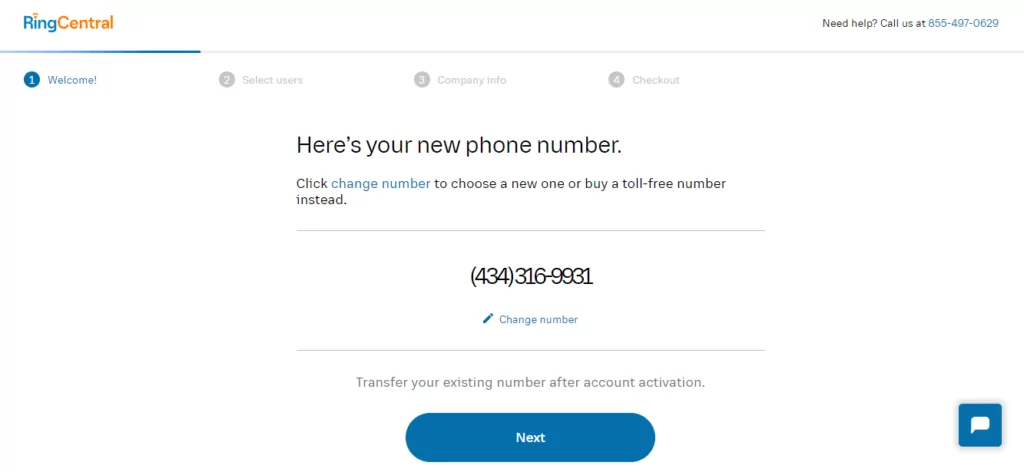
RingCentral prompts you to choose a local or toll-free number during checkout. However, you won’t be able to port in your existing number until after you’ve paid for a plan.
You should know any toll-free numbers added to your plan come with an additional cost. RingCentral charges $30 upfront for any 800 toll-free numbers you purchase — even during the free trial.
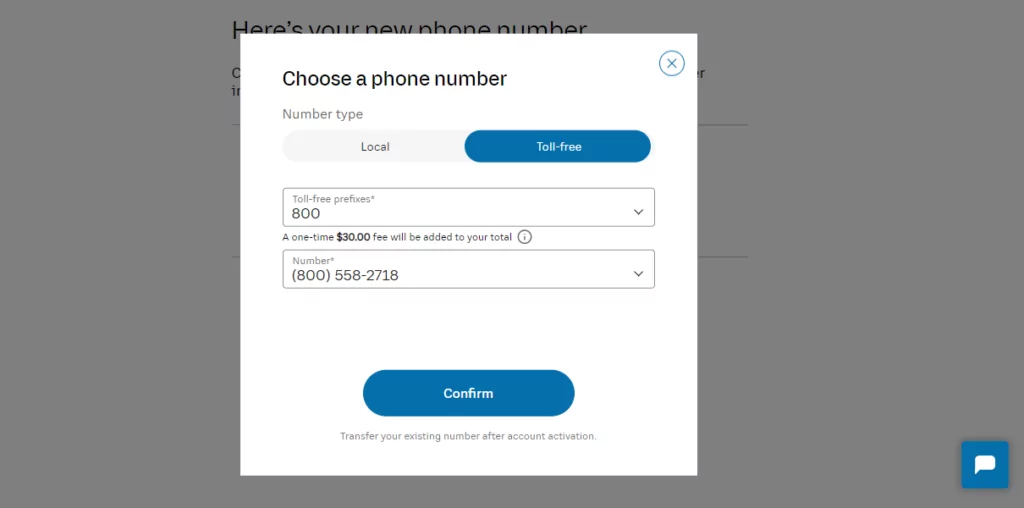
3. Start your free trial
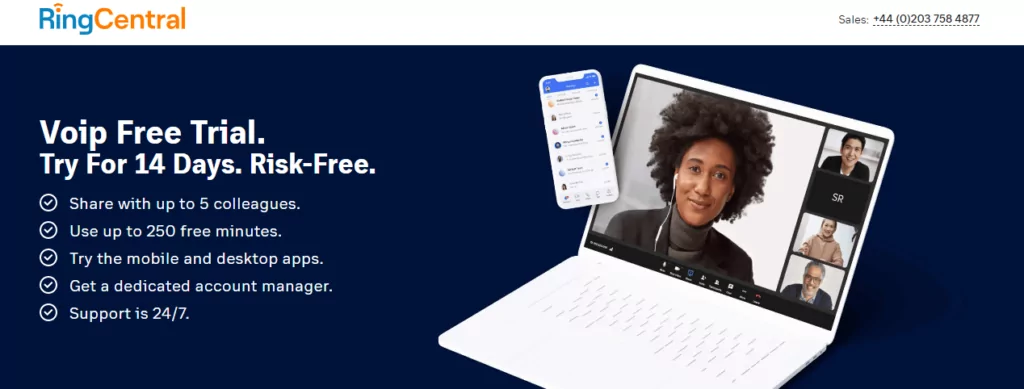
If you want to give RingCentral a try without paying for a full plan, you can start with a 14-day free trial. However, there are lots of limitations to contend with — and a limited feature set is chief among them.
For example:
- You can only use the free trial with a max of five users and two desktop phones. If you decide to borrow any hardware from RingCentral, you have to return it within 21 days to avoid getting charged.
- The free trial includes only 50 minutes of domestic calls per user. Most business calls last about four minutes on average, which means you only have 12 calls per user (or 60 calls total) to test the quality of RingCentral’s phone system.
- You can’t test out texting at all. You need to pay for a full plan to send SMS and MMS, although your bandwidth is still limited (more on this later).
The only way to avoid these limitations is to skip the free trial and pay for a plan.
4. Download the apps
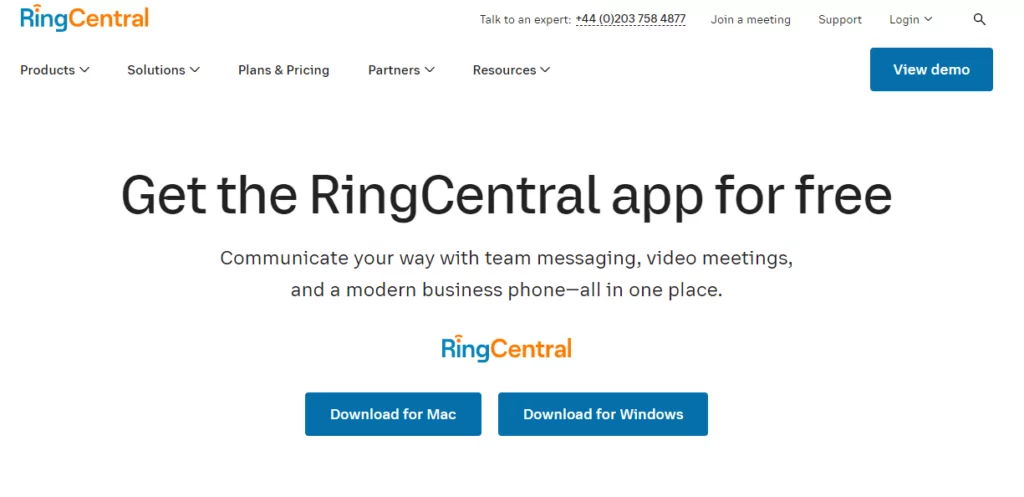
If you decide to sign up for the free trial, you have the option to download RingCentral’s apps. The mobile app is available for Android and iOS, and the desktop app is compatible with Mac and Windows. You can also use their browser app to make phone calls from Chrome or Firefox.
However, RingCentral’s app quality isn’t well perceived. Many customers cite bugs and performance issues that prevent them from serving customers effectively. Just take a look:
“The new desktop app is glitchy, I get missed call notifications after a couple of hours, We have to download images before we can just print or print to PDF, sometimes this creates the app to freeze.” – TrustRadius
“In my experience, their usability is TERRIBLE. We had dropped calls nonstop, customers were unable to hear us, and their app is unusable.” – TrustRadius
“Navigating the RingCentral app for messaging is a little clunky and non-intuitive. Sometimes, if I enter a phone number into the phone app too quickly, it interprets it as an internal extension, and I accidentally call one of my coworkers.” – TrustRadius
You can see RingCentral is a dated legacy system that can be tough to get up and running. However, this is just the tip of the iceberg. There are many other limitations you should know about before committing to an annual plan — including the nine listed below.
9 other major drawbacks of RingCentral
RingCentral suffers from extensive limitations during its free trial and comes with expensive up-front costs that aren’t common for other VoIP providers. However, there are additional RingCentral drawbacks to consider even after you’ve signed up.
Here are 9 of the biggest to keep in mind:
1. RingCentral’s base plan lets you only have up to 20 users
If your team needs more than 20 users on RingCentral, their platform forces you to upgrade to their Advanced plan ($25 per user per month) — even if you don’t need any additional features on that plan. —
2. Integrations are more expensive with RingCentral
CRM integrations aren’t available on RingCentral’s basic plan. If you want access to Salesforce and other CRM integrations, you need to upgrade and pay a minimum of $25 per user per month.
3. No options to share responsibility for incoming texts
RingCentral’s shared phone number feature is only useful for incoming calls. While you can use shared lines to answer calls with other members of your team, you won’t be able to field incoming texts together. This creates a bottleneck that can slow down your responsiveness and make it difficult to answer questions quickly.
But this isn’t the end of RingCentral’s limitations for text messaging —
4. RingCentral provides a low limit for text messaging
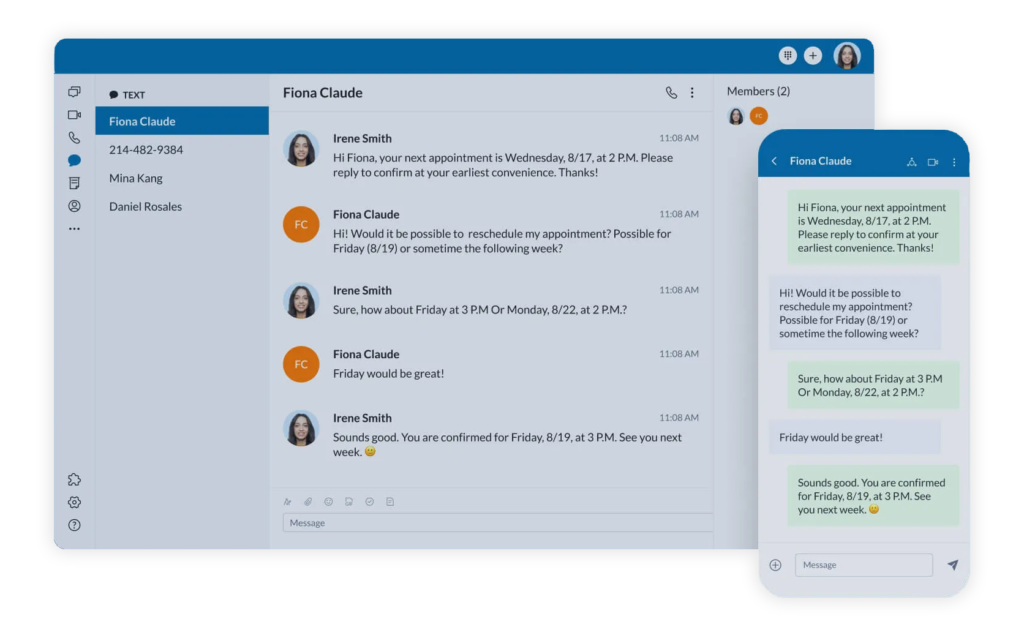
There’s no such thing as unlimited free SMS on RingCentral. Every plan comes with a set amount of business SMS/MMS messages per user. In the United States, your limit is:
- Core: 25 per user
- Advanced: 100 per user
- Ultra: 200 per user
In Canada, your limit is even smaller:
- Essentials: 25 per user
- Standard: 50 per user
- Premium: 100 per user
- Ultimate: 250 per user
Using more than your allotted amount results in excess usage rates (which apply to both inbound and outbound messages). The only way to offset this is to purchase prepaid text message bundles, which cost an unspecified amount after you sign up.
5. Getting the right context takes more time than it should
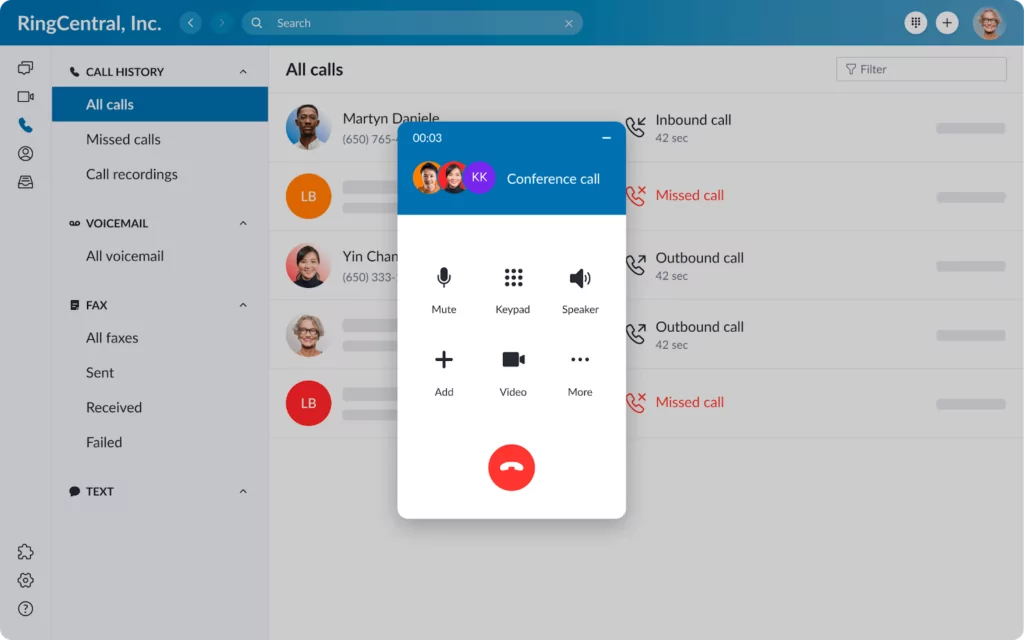
RingCentral separates all calls, texts, and voice messages into different inboxes. This means you can’t quickly look at all points of communication between a contact and your brand, making it hard to look back on past interactions and follow up if necessary. If you need to delegate tasks to other team members or ask for clarification, it might take a long time for everyone to find specific texts or voice messages.
6. Caps storage
RingCentral doesn’t let you store an unlimited amount of data. This means all your call recordings, voicemails, faxes, texts, and call logs expire after a set amount of time. For example:
- Automatic and on-demand call recordings expire after 90 days
- Faxes expire after 30 days
- Call logs expire after 12 months
Even if you upgrade to RingCentral’s Ultra plan ($35 per user per month), these retention periods still apply.
But time isn’t the only factor affecting your data storage. RingCentral has other limitations that eat into your data. For example:
- You can only have 100,000 automatic call recordings per account and 200 on-demand call recordings per user
- You can only store 5,000 text messages per user
- If you have 200 unread voicemails, any new voicemails override existing files
Whether you run out of time or exceed your storage limit, RingCentral caps your storage capabilities — even after upgrading to a plan with ‘unlimited’ storage.
7. Caps your toll-free minutes
RingCentral gives you a set amount of toll-free minutes you can use per month. This applies to all inbound calls you receive from toll-free numbers.
The total minutes you get depends on the plan you pay for:
- Core: 100 minutes per month
- Advanced: 1,000 minutes per month
- Ultra: 10,000 minutes per month
So odds are if you choose to use RingCentral, you’re paying at least for the Advanced plan ($25 per user per month). Plus, all your toll-free minutes are pooled for everyone on your account, regardless of how many lines you have. If you want more minutes, you need to purchase them separately — and you won’t know the price until you sign up for an account.
If your business relies on a toll-free phone number to reach customers, this could be a huge limitation — especially as you scale up and your team spends more time on the phone.
8. No voicemail transcriptions and limited recording storage
You can’t access voicemail transcriptions on RingCentral’s Core plan. You need to upgrade to the Advanced plan ($25 per user per month) to unlock this standard feature.
Keep in mind you won’t have ‘unlimited’ storage for call recordings with RingCentral unless you pay even more for the Ultra plan.
9. RingCentral throws in features more relevant to contact centers
RingCentral claims it was designed for small business owners, but many of its upgraded features are more relevant to contact centers. For example, if you upgrade to the RingCentral MVP’s Advanced plan to unlock automatic call recordings, you simultaneously unlock unlimited internet fax — something most small business owners don’t really need.
Want to unlock CRM integrations with Salesforce and Zendesk? Your plan includes multi-site admin and management — not helpful if you have just one business location.
To summarize: if you upgrade to access more small business features on RingCentral, you might end up paying for features you don’t need.
Is RingCentral safe?
RingCentral advertises seven layers of UCaaS defense. A few examples of these security features include:
- Multi-factor authentication
- Anti-malware
- Cloud threat monitoring
- Application security
- Standards-based encryption
- Developer API keys
- Cloud security infrastructure
But as you saw with the limitations above, that’s not only the factor in play.
OpenPhone: The best business phone solution for growing teams
RingCentral may be a popular VoIP solution for contact centers, but thanks to its pricey upgrades, capped features, and limited text messaging service, it doesn’t lend itself well to growing teams. You may spend hundreds of dollars per month just to access basic features — and still have to pay for services you don’t need.
If you want the freedom of RingCentral’s cloud-based communications without the hefty price tags, OpenPhone is the obvious next choice. As a small business VoIP service designed for expanding businesses, we make it easy to scale your phone service alongside your business.
Here are a few key reasons thousands of companies have voted OpenPhone the best small business phone system on G2:
1. Know how much you’re investing upfront
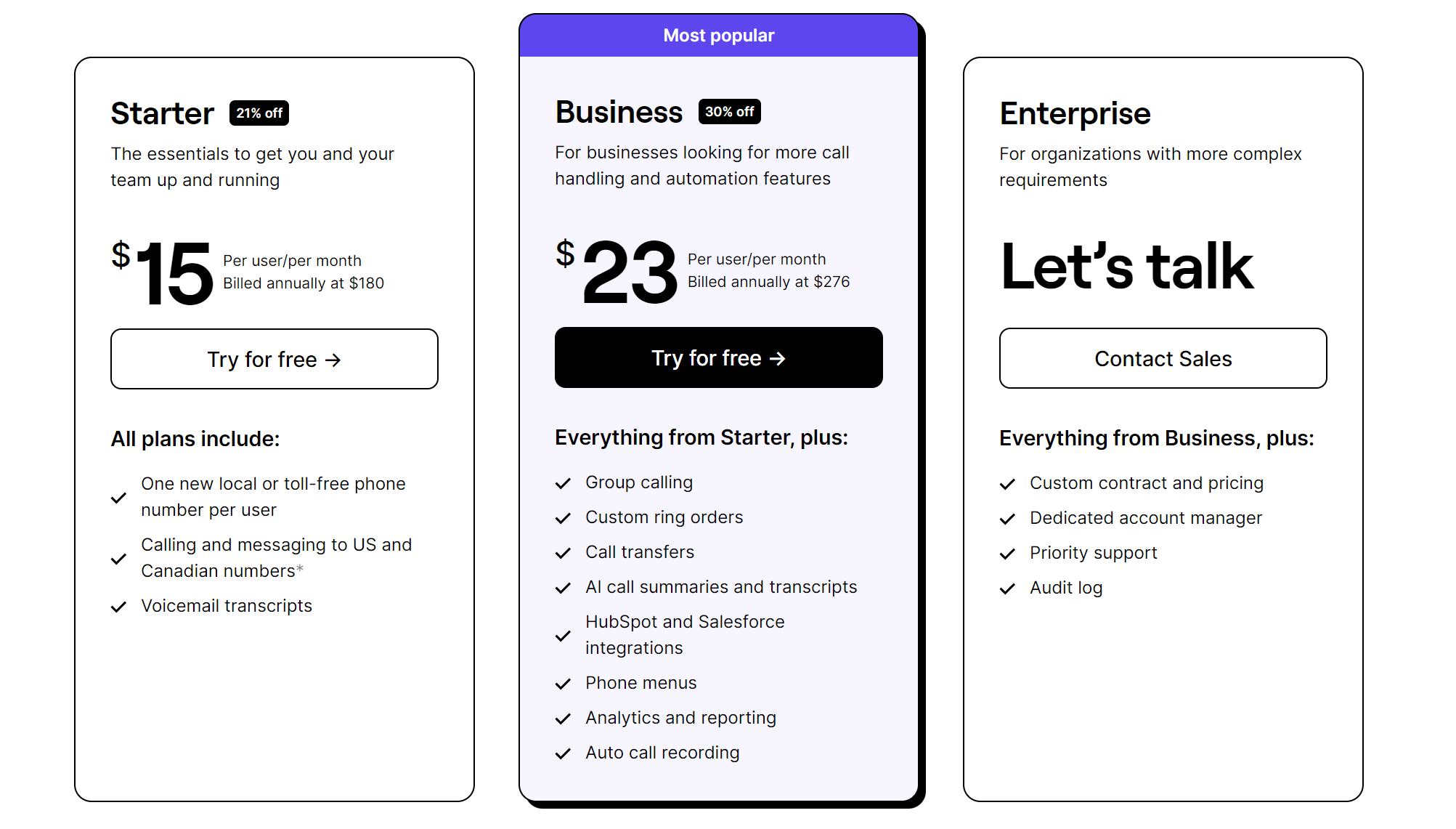
OpenPhone is serious about transparency, especially when it comes to prices.
The basic plan starts at $15 per user per month. Each user on your plan includes one free local US, Canadian, or North American toll-free number. You only need to upgrade when you’re ready — there are no limits to how many users you can have on one plan.
OpenPhone also makes it easy to evaluate prices before you scale, including the services you might need when your company gets bigger. Need additional phone numbers? You pay just $5 per number per month. Want to estimate costs to reach customers overseas? You can browse our rates for international calls and texts. If you want to send automated SMS via Zapier, you’ll pay $0.01 per message.
With OpenPhone, you won’t have to pay for any features you don’t need. Every new tier lets you access new features that make sense as your business grows, including call transfers, analytics and reporting, and audit logs. Call recording is always available on the basic plan. Unlike RingCentral, you don’t need to pay for domestic call minutes — inbound calls for toll-free numbers are always free and unlimited.
2. Work together from a shared inbox
OpenPhone lets you split responsibility for incoming calls and texts so no incoming communication slips through the cracks. For example, you can centralize all your team members onto a shared number, which lets everyone answer calls, respond to texts, and browse contact histories at the same time.
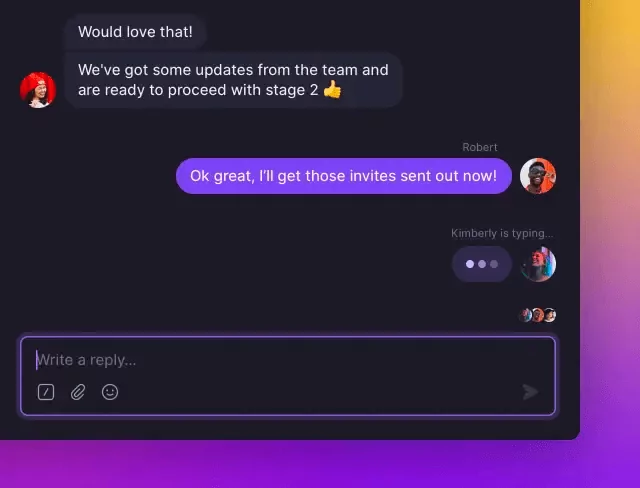
You can even see when a teammate is actively responding to a customer.
With shared numbers, you can use simultaneous ring to alert other devices when a phone call comes through. This means there’s always someone around to pick up the phone for your customers. If you need to delegate a specific task before you clock off for the day, just tag a co-worker in an internal thread and let them know what needs to be done. You don’t have to leave the app or integrate with a third-party tool — unless you want to, that is.
3. Integrate the tools you use without overpaying
OpenPhone offers dozens of app integrations that seamlessly connect with your existing tech stack. For example, you can hook up your current CRM (like Salesforce or Hubspot) to auto-log phone activities and sync your contacts. You can also forward missed calls or text messages to Slack so the right people or channels can prioritize specific incoming communication.
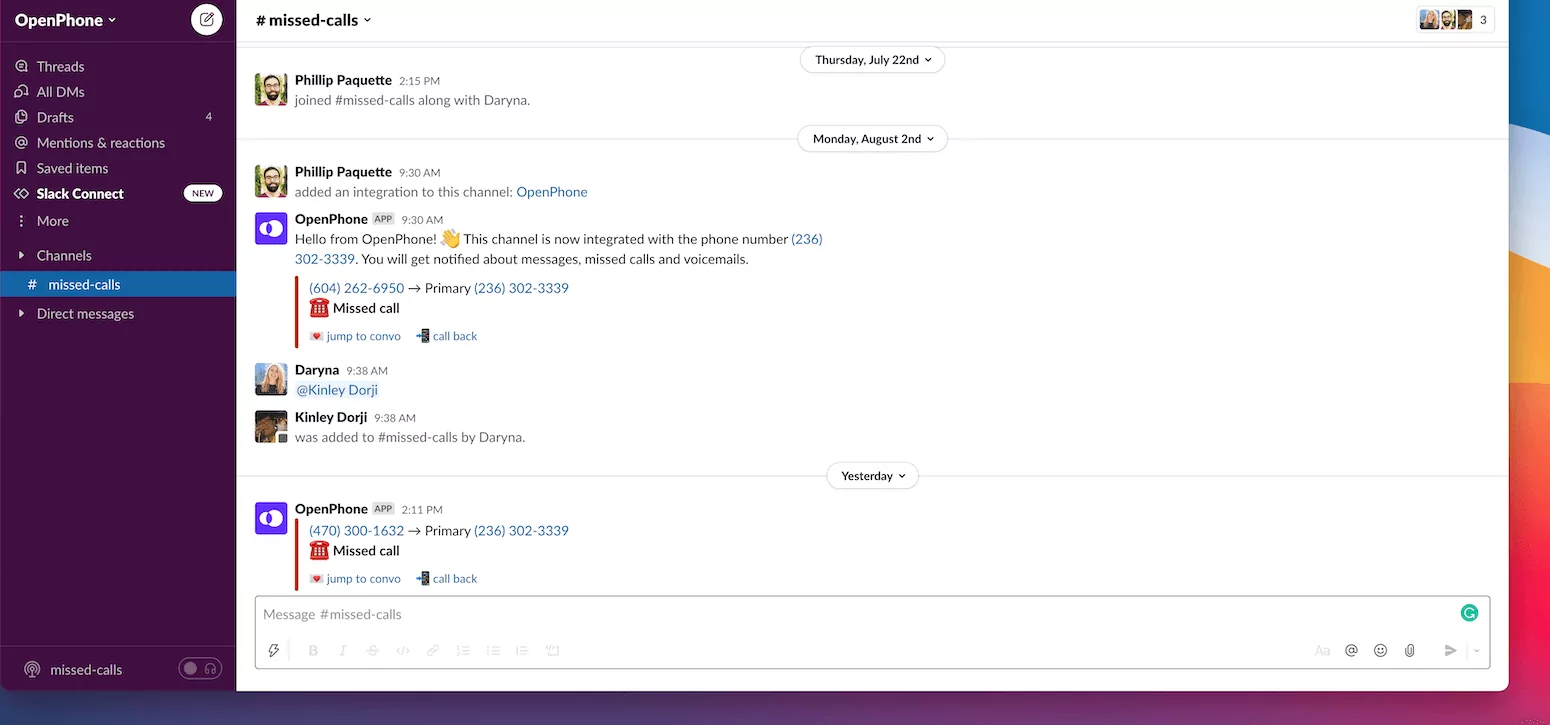
If you want to connect OpenPhone to other tools you use, you can add Zaps to create more than 5,000+ integrations with third-party tools.
4. Follow up faster
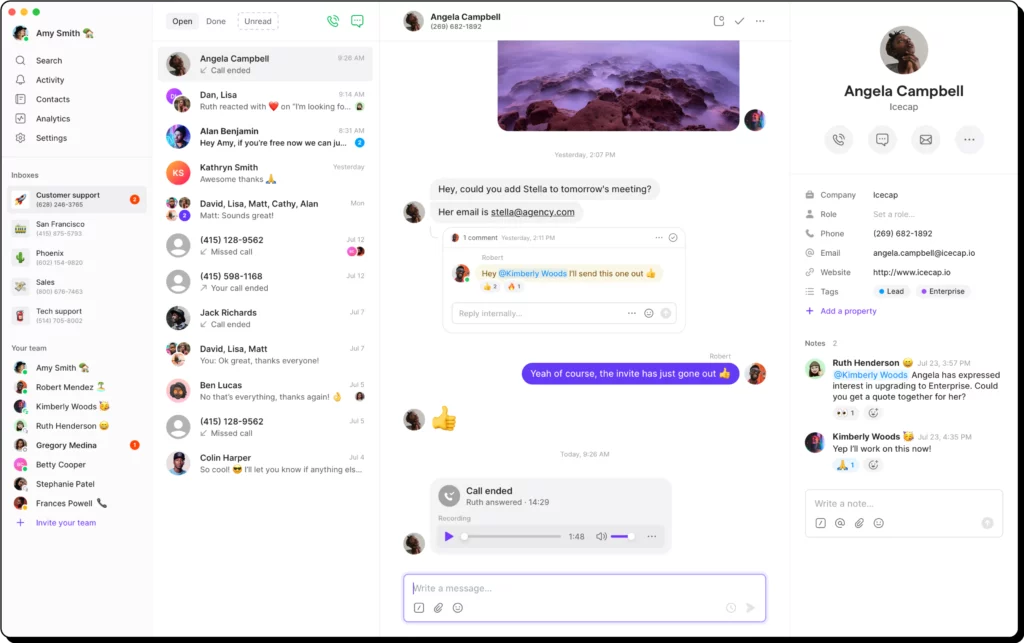
Unlike RingCentral, OpenPhone doesn’t split up communications by type. All call recordings, texts, and voice messages with a contact are in a single view so your team can instantly get the right context to follow up. And if you’re using a shared number, you can collaborate in context with your team using threads and mentions. Just ‘@’ someone on your team (like ‘@Sam’) and leave a note with details or instructions for them to follow.
Your customers can’t see these threads at all, and your team can keep working together without needing to jump off-platform.
You also don’t have to worry about data storage with OpenPhone. All conversation history stays in OpenPhone for as long as you have an active account. There’s no need to upgrade for unlimited storage, and no reason to delete specific messages to try to get around data limits.
5. Text as much as your team needs
Texting on OpenPhone is available on the free trial, so you can always try before you buy. Plus, you can send unlimited SMS and MMS messages to anyone in the US or Canada for free with your OpenPhone plan. You’re not limited to just 25 messages per user, and you don’t need to worry about overage fees.
OpenPhone also makes it easy to automate the texting process with your customers. For example:
- You can use saved snippets to create templated messages and answer FAQs more consistently. Once you have a message in OpenPhone, just type ‘/snippets’ to pull it up and customize it.
- If you want to engage your customers even after hours, you can set up auto-replies to instantly set their expectations. Every missed call or voicemail triggers an auto-reply to let customers know you got their message — and will be back soon to answer their questions. Customers know they’ve reached the right person, and you don’t have to stay glued to your phone to provide instant responses.
- Scheduled messages help you send the right text at the right time, especially for customers overseas. You can select a date and time for your message to go out so you don’t have to do it manually. If a customer sends another text before your message goes out, OpenPhone cancels the auto-send in case there’s something you need to address.
- Want to automate specific touchpoints with your customers? You can create workflows in Zaps that connect different triggers with one another. For example, you can create a workflow that sends appointment reminder texts to customers after they fill out a web form.
OpenPhone is a better alternative to RingCentral MVP
OpenPhone is far and away the best RingCentral alternative for small business owners. In just 15 minutes or less, you could start making or taking phone calls from a local, Canadian, or toll-free number.
Take advantage of our seven-day free trial to test out our platform with your team.
